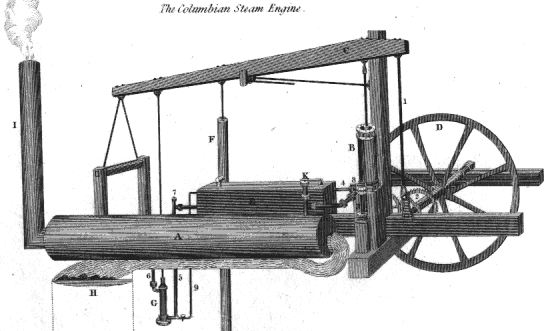Oliver Evans
Today, we see what guns and steam engines have to do with each other. The University of Houston's College of Engineering presents this series about the machines that make our civilization run, and the people whose ingenuity created them.
Many engineers of the late 17th century were trying to make use of two new sources of power: steam and gunpowder. By then, England and Europe were under the threat of a serious energy crisis. Most of the trees were gone, and the depth of coal mines had reached the underground water table. A reliable power source was badly needed to pump water out of the mines so people could keep heating their homes.
No one got very far with gunpowder. But about this time two Englishmen finally invented workable steam engines. They both came from Devonshire, but they didn't know each other. In fact, one of them — Thomas Savery — was an aristocrat, while the other — Thomas Newcomen — was a blacksmith.
The blacksmith, Newcomen, provided the better of the two engines. It produced power when steam was condensed in its cylinder to create a powerful vacuum. From then on, for many years, steam engines operated at low pressures.
The first important American steam-engine builder was a Philadelphia engineer named Oliver Evans. Evans saw steam-engine building in relation to gun-making and made his engines with small high-pressure cylinders — like gun barrels.
His engines weren't very fuel-efficient, but they were light, and they performed well. They were especially well suited to our greatest need, which was transportation.
And so, on a summer's day in 1805, the doors of Evans's Philadelphia workshop swung open, and out rolled the most remarkable transportation machine the world had ever seen. It was a gigantic steam-powered behemoth that he called the Oructor Amphibolos — Latin for "Amphibious Dredge." This strange, awesome machine could have lumbered straight off the set of a Mad Max movie. It rolled down the streets, around Centre Square, and off into the Schuylkill river where it sailed about for several hours, dredging mud.
Evans saw beyond gun-making to a larger issue — straight through to America's need for powered transportation. In one stroke, this wonderfully inventive man had made one of our first horseless carriages; and he'd invented a steamboat, two years before Robert Fulton did.
I'm John Lienhard, at the University of Houston, where we're interested in the way inventive minds work.
(Theme music)
Pursell, C. W., Jr., Early Stationary Steam Engines in America. Washington, D.C.: Smithsonian Institution Press, 1969, Chapter 4.
Bathe, G. and Bathe, D., Oliver Evans. New York: Arno Press, 1972.
The very first program I did, Episode 1, was an ongoing benchmark for me. And so I redid it twice, once as a simple revison (Episode 264) and once as an elaboration of Oliver Evans's story (Episode 285).

From the 1832 Edinburgh Encyclopaedia
Oliver Evans's High-Pressure Columbian Engine